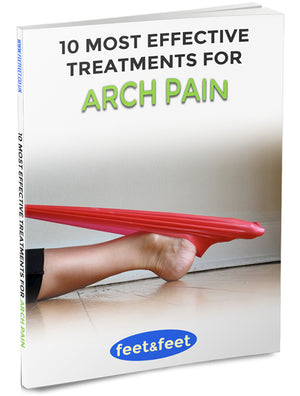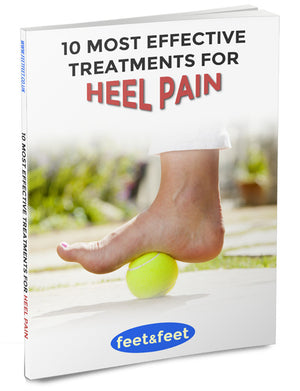What is a Bunion?

A bunion (medical term: hallux valgus) is a bony lump on the side of the foot that develops when the first metatarsal bone starts to jut outwards at the joint where it meets the base of the big toe. This is often results in the big toe pointing inwards towards the other toes of the same foot.
A common condition, it's thought that as many as half of the adults in the UK may be affected by a bunion. According to the Harvard Medical School, women are ten times more likely to have a bunion, while the risk is also higher for older people and those of African American race.
Individuals with a higher BMI (body mass index), who wear ill-fitted footwear and who have other foot conditions such as flat feet, may be more likely to experience a bunion.
Read on to discover the causes and symptoms of a bunion, as well as the best types of treatments for a bunion.
What Causes a Bunion?
Despite knowing what a bunion is, it's a different story when we look into what causes a bunion. The development of a bunion tends to involve a complex interplay of different factors over time and is not perfectly understood yet. However, the following factors can increase the risk of getting a bunion:
- Wearing the Wrong Footwear – Wearing tight and ill-fitting shoes, particularly high heels and narrow shoes, can increase the risk of developing a bunion. This is because these types of footwear can cause friction over the joint of the big toe, push the toes together into an unnatural position and increase the strain on the joints, muscles and the bones of the foot. The use of high heels is thought to explain why women have a much higher risk of developing bunions.
- Genetics and Foot Structure – Bunions often run in families because of the hereditary nature of foot shape and structure. Having certain foot conditions such as flat feet or low arches may also be a cause of bunions, as loose tendons and unusually flexible joints can progress its development.
- Health Conditions – Some types of health conditions may increase the risk of developing bunions. Various types of arthritis, such as rheumatoid arthritis, gout, psoriatic arthritis and osteoarthritis may all be linked to the development of bunions.

Bunion Symptoms
Bunions tend to form slowly, over many years, and the symptoms vary greatly in severity. Some symptoms that are commonly associated with bunions may also be caused by other health conditions, so it's always good to see a GP when in doubt. The main bunion symptoms include:
- Changes to Foot Shape – In addition to the development of the bunion, the big toe may turn towards the other toes, leading to overlapping toes. If this occurs, not only will finding the right footwear be difficult, but pain will likely increase as the joints of the toes will rub against each other.
- Aches and Pain – Bunions can cause pain and stiffness over the big toe joint. The pain may feel worse when walking or wearing shoes because increased pressure on the bunion.
- Skin Appearance – The skin over the affected area can change in appearance. There may be swelling, redness, blisters, hardness or calluses. Over time, the skin may begin to look shiny and feel warm to touch.
- Gait and Balance – A bunion can also affect your balance and the way you walk, particularly if it’s painful.
How to Fix a Bunion
Bunions don't always cause problems and may not need treatment. However, if they get painful or otherwise bothersome, there are both non-surgical and surgical treatment options, depending on the severity of the problem.
Anyone keen to find out how to fix a bunion should be aware that while non-surgical treatments can be used to manage the symptoms, only surgery can correct the deformity.
So how do you treat bunions symptoms without surgery? The following treatments may help lessen the symptoms of a bunion:
- Medication – Both prescription and over-the-counter pain relievers, such as paracetamol and ibuprofen, may be taken to manage pain and swelling. If the bunion is connected to arthritis or the pain is especially severe, stronger medicines may be prescribed by a GP. Always keep in mind that there can be harmful side effects when taking any form of medication.
- Bunion Pads – These are designed to ease the pressure on the bunion and to protect it from friction caused by rubbing against the inside of a shoe. Bunion pads can be made of fleece or gel and either stick over the bunion, or held in place with a loop that goes around the big toe.
- Orthotics – These are devices that are designed for managing a specific condition of the foot. Such devices include insoles and splints that can be worn inside a shoe to cushion the bunion against pressure and to help realign the bones of the foot. Orthotics may or may not be customised.
- Footwear – Wearing shoes that are comfortable and have flat or low heels and plenty of room for toes can ease the symptoms of bunions. Shoes can also be custom-made specifically to relieve the discomfort of bunions.
- Heat and Ice – Pain and swelling associated with bunions can be eased by applying an ice pack (wrapped in a towel) over the affected area a few times per day. Some people prefer to bathe their feet in warm water or apply a heating pad over the bunion.
- Physiotherapy – Exercises that strengthen the muscles and tendons of the big toe may help ease some of the symptoms.
How do you get rid of a bunion surgically? There are over 150 different surgical procedures, though only a handful are routinely performed. These include:
- Bunionectomy – This involves cutting the ligaments at the affected joint to realign the big toe. The operation is usually performed in a hospital under general anaesthesia.
- Osteotomy – This is a common operation performed to treat severe bunions. Part of the bone is cut off to remove the lump, and the big toe is moved back into a more natural position. Wires or screws may be inserted to hold the bones in place.
- Distal Soft Tissue Realignment – This type of operation alters the soft tissues of the foot. The procedure aims to improve both stability and the appearance of the foot.
- Arthrodesis – This may be recommended for cases when the joint is severely deformed. The two bones at the joint are fused together during the procedure. The big toe will have limited mobility afterwards.
- Excision (Keller's) Arthroplasty – The bunion as well as the toe joint is removed in this type of operation. As scar tissue forms, it is used to create a false joint that is temporarily pinned in place with wires.
- Minimally Invasive Bunion Surgery – This relatively new type of bunion operation is performed to correct the position of the big toe. Small incisions are made into the skin near the big toe, to access the bunion which is removed with bone-cutting instruments. One or more bones of the front foot may also be divided and secured in their place with screws, wires or plates.






Leave a comment